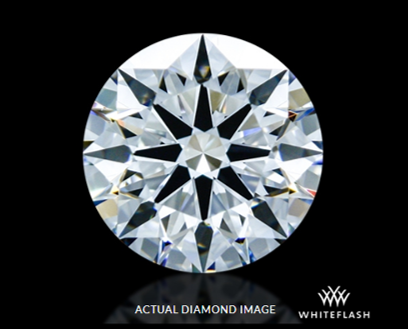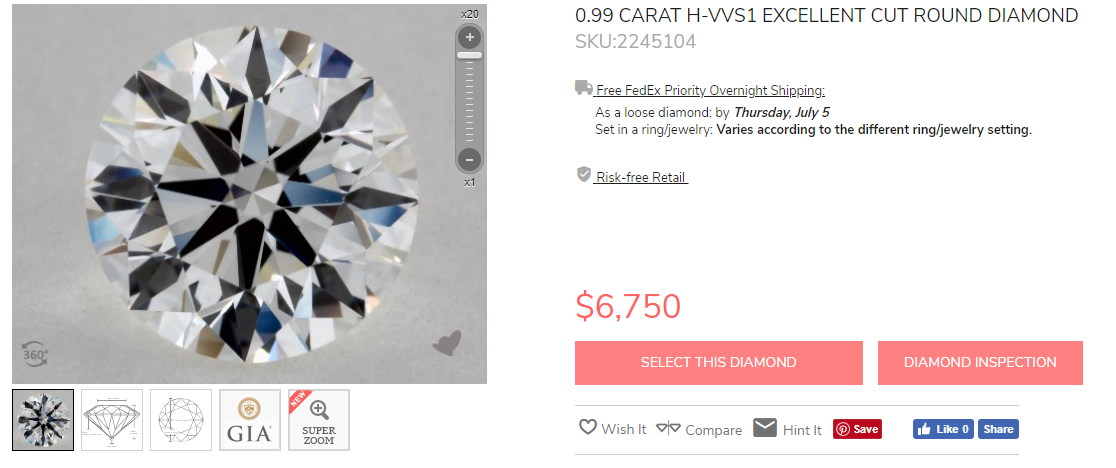This article has mentions of products from one or more companies, and I may receive compensation if you purchase those products following reading my recommendations.
Buying a VVS Diamond
When you take your first step on the path of diamond buying, you will immediately hear a flurry of phrases and acronyms that you may not have considered before.
Another question that I’m asked about often is the clarity grades that are used when determining diamond quality.
Understanding the variations within these grading categories will ensure you are getting the most beautiful diamond for the best price possible.
Finding this balance goes far beyond looking for a flawless diamond; these rare beauties will cost into the tens of thousands and beyond for anything of a reasonable size. Rather, it is about understanding what looks the best while allowing you to devote equal funds and focus on coloring, and perhaps a little more to the cut.
I hear from many buyers that they have been recommended a VVS grade diamond (often while in a jewelry store), with promises that at this level the diamond will be eye-clean and of the best quality and value.
I implore buyers to go beyond this, as just a little research and understanding can save you thousands.
The Clarity Grading System
The below grades have been outlined by the GIA. As the most internationally respected gem laboratory, GIA testing standards are incredibly stringent meaning the results are accurate and in-depth.

The grades are defined as follows:
- Flawless (FL)- No inclusions or blemishes are visible to a skilled grader using 10× magnification
- Internally Flawless (IF)- No inclusions and only blemishes are visible to a skilled grader using 10× magnification
- Very, Very Slightly Included (VVS1and VVS2) - Inclusions are difficult for a skilled grader to see under 10× magnification
- Very Slightly Included (VS1and VS2) - Inclusions are minor and range from difficult to somewhat easy for a skilled grader to see under 10x magnification
- Slightly Included (SI1 and SI2) - Inclusions are noticeable to a skilled grader under 10x magnification
- Included (I1, I2, and I3)- Inclusions are obvious under 10× magnification and may affect transparency and brilliance
The GIA grading certificate will contain a diamond ‘map’ or ‘diamond inclusions plot’ which outlines the position and type of inclusions present in each individual diamond. However, the GIA does not mention whether or not the diamond is ‘eye-clean’.
Eye-clean or eye-clear describes a diamond that has no inclusions visible to the naked eye. Companies like Whiteflash include this in their Diamond Performance.

What Are VVS1 Diamonds?
A diamond with a VVS1 grading is the closest to an IF (internally flawless) stone. At this level, even a skilled expert will not be able to identify any blemishes or inclusions under a 10X magnification.
A grader will consider various aspects when analyzing the stone.
- They will first consider the size of the inclusions. If, for example, the inclusion can be seen under a 10x magnification, it will be graded lower than a VVS1. If the inclusion is large enough to be seen by eye, it will receive a lower grading and so on.
- The grader will also consider the positioning of the inclusion. Inclusions closer to the table will be far more visible than those in the crown and pavilion.
- The color intensity of the inclusions is also considered; inclusions can range from imperceptibly light in color, to black.
Diamonds graded at VVS1 will have absolutely no inclusions or blemishes visible to the naked eye.
Whiteflash A CUT ABOVE® Hearts and Arrows Diamond

If we look at this VVS1 from Whiteflash, even the magnified photograph shows no inclusions. We can then compare this with the AGS certificate.
Whiteflash A CUT ABOVE® Hearts and Arrows Diamond AGS Report

The diamond inclusion plot shows that there are three, small pinpoint inclusions in the upper right side of the diamond. These are not visible to the naked eye, nor can they be seen in the high-res photograph.
What Are VVS2 Diamonds?
VVS2 is the second class of VVS diamonds. They are assessed and held to the same scrutiny as a VVS1 diamond, with the number of inclusions, their placement, size, and color all assessed.
The significant difference between VVS1 and VVS2 stones is the positioning of the inclusions. A VVS2 stone will have inclusions visible from the crown when looked at beneath a 10x magnification.
To the naked eye (expert or otherwise) inclusions will not be visible in a VVS1 or VVS2 stone, making it impossible to distinguish them without magnification.
Diamonds graded IF, FL, VVS1 and VVS2 will have no inclusions visible to the naked eye. The clarity is exceptional and viewing any diamond of these grades is essentially equivalent to viewing a flawless stone. For the best quality VVS Diamonds I would opt for a A CUT ABOVE® diamonds from Whiteflash.
How Much Do VVS Diamonds Cost?
Like all diamonds, the price of a VVS stone is greatly dependent on the other 4 Cs. There is, however, a large jump between VS and VVS diamonds.
There is a misconception, one that is often fueled by jewelry salespeople, that opting for a VVS clarity is an ‘investment’. The truth is that a diamond will cost you a great deal more and your loss on re-sale will be exactly the same as any clarity below this.
Diamonds suffer loss at re-sale like any other retail purchase and spending more on a higher clarity will not protect against this.
If VVS is the route you want to go down, do make sure you select the jewelers that have the best upgrade scheme. Whiteflash, by far, has the most impressive diamond trade-up service I can see on the market. I would also consider the Blue Nile Diamond Upgrade Program.
If we look at the James Allen diamonds below, we can see the difference that one clarity grade can make.


As these two excellent cut, round brilliant diamonds from James Allen show, moving from a VS to a VVS will certainly add to the final cost. The difference here is $330 – though other stones may show a greater difference in price, comparing these two diamonds accurately demonstrates the superfluity of the spend. These two diamonds would appear absolutely identical to the naked eye.
The difference between a VS and a VVS can be anywhere from $300 to $2000.
Where to Buy VVS Diamonds
Ultimately, choosing a VVS clarity grade is spending money on something that you cannot see and will not increase the resale value of your diamond. There is a wealth of beautiful, eye-clean stones at an SI1 grading that are a fraction of the price, allowing more of your budget to be spent on an excellent cut, a good color or perhaps even more diamonds.
However, I fully understand that choosing a higher diamond clarity grade is a personal choice. If budget allows, go for the highest grade you can afford. All of the 4Cs need to work in harmony to ensure you're purchasing the best stone.
When looking at any grade of diamond, it is essential that you are able to view the stone itself in the best possible conditions.
Whiteflash offers 360° imaging, and state on its diamond specifications whether or not the diamond is eye-clean. This information is not currently offered by many vendors, meaning Whiteflash have the upper hand, not only when it comes to cut quality, but also with buying eye-clean diamonds online.
James Allen also offers extremely high-resolution photographs of the diamond itself, as well as 360° imaging that will allow you to view the diamond up to a 20x magnification.
It is easy to assume that spending more is the right way to get the best quality diamond; however, your eyes are the most important tools when choosing a diamond. Use them, trust them and when in doubt ask an expert.

